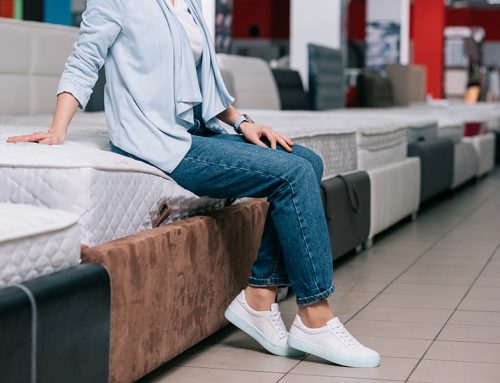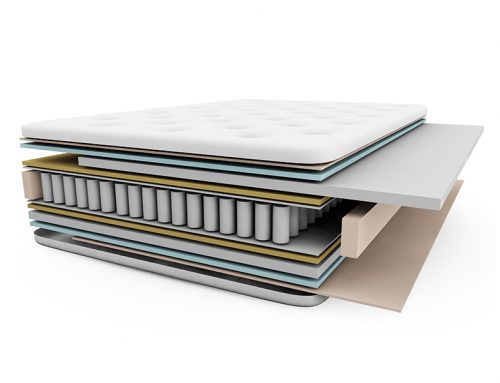A new mattress is a serious investment—one that you’ll likely be living with for the next 8-10 years. Despite many new mattress brands offering generous trial periods and returns policies, it can still be difficult to get the facts straight on foam versus spring construction, and why you might want to opt for one design over the other.
This post is designed to help you make that decision.
Foam mattresses
Table of Contents
Partly because of its origins in a NASA funded research and development project, memory foam is the first thing many people think of when they see the words ‘foam mattress.’ But not all mattress foam is memory foam, and not all memory foam is made equal! Mattress manufacturers employ a variety of different types and densities of foam in their mattress construction, with each mattress offering a different prospect in terms of support, longevity, and value for money.
Definition
Here’s a run-down of the most popular types of mattress foam, and where inside a mattress you’re most likely to find them:
- Polyurethane Foam. This is the daily driver of mattresses foams—cheap, durable, and appropriate for multiple applications. Poly or Polyfoam is the industry standard for filling in space between the base of a mattress, any topping, and more premium internal layers. In other words, polyfoam is what you’ll find surrounding the parts that mattress manufacturers really want you to focus on! Beware a mattress constructed entirely of plain polyurethane, however. While it may feel sumptuous soft on arrival, it’s likely to quickly degrade. Plus, better quality, the denser foam has been shown to be more resistant to dust mites, making it more hygienic in the long term.
- Memory foam. As said above, memory foam is so ubiquitous that it’s often a stand-in for all types of foam mattresses. Chemically reinforcing and conditioning polyurethane makes it viscoelastic, allowing memory foam to react to a sleeper’s body heat, softening at pressure points to accommodate body shape, and returning to a flat surface when weight and heat are removed. Lower-priced memory foam mattresses are normally created from traditional memory foam—solid blocks of foam that have a reputation for retaining too much body heat. More modern and expensive options include open-cell memory foam, which, as the name suggests, has a more open, airflow-inducing structure. And gel memory foam, which uses a gel infusion to insulate against heat and provide a cooler night’s sleep.These days, most foam mattresses from an intermediate price point upwards include some sort of memory foam layer. You most regularly find memory being used as a pressure reliever for the hips, shoulders, or head.
- Latex and natural foam. Mattresses constructed from latex foam have a similar level of responsiveness to memory foam, while also offering a surface created from the all-natural source of rubber trees. This often makes latex an environmentally friendly and hypoallergenic mattress choice (except for those with latex allergies, obviously), but it’s also important to point out that cheaper latex mattresses may also be synthetically produced. According to Sleep Advisor, synthetic latex will often have less bounce and feel very similar to memory foam.
The new technology on the block
 Foam mattresses on the low end of the price spectrum recreate the feeling of traditional springs by using low-density materials, which can feel indulgently soft. The lifespan of such mattresses tends to be much shorter, though, making them more suitable as a temporary solution—in a short term rental, for example.
Foam mattresses on the low end of the price spectrum recreate the feeling of traditional springs by using low-density materials, which can feel indulgently soft. The lifespan of such mattresses tends to be much shorter, though, making them more suitable as a temporary solution—in a short term rental, for example.
As you increase cost, the level of foam technology, and quality of materials, increases. The more expensive a form mattress, the more engineering it will likely contain. This might mean introducing layers of memory foam to isolate movements, or levels of foam to meet different weight demands. Foam mattresses often employ a construction where certain foams only come into play when weight compresses the mattress, leading to that love-it-or-hate-it feeling of sinking into your bed.
In general, you can always expect a higher level of movement isolation for your money with foam as opposed to springs. Because it’s easier for manufacturers to swap out different densities of foam, most brands offer different construction options, including super firm models for maximum absorption.
Finally, thanks to the ongoing research and development of foam mattresses, materials continue to decline in price. This means that today’s top-spec foam materials are often found in next season’s budget mattresses. Take the latest trend for mattresses infused with antimicrobial compounds, such as charcoal and aloe vera, for example.
Why foam might work for you
- Good quality, high-density foam effectively blocks dust mites, mold, and other allergens.
- Cheap, low-density foam can provide excellent comfort value for short-term use.
- A memory, latex, or reflex foam mattress will change its shape according to how weight and pressure are distributed across your body, encouraging ideal spinal alignment when prone.
- Foam mattresses often come compressed inside cardboard boxes that can be comfortably carried by two people, and navigated through spaces were full-size mattresses may not fit—such as a narrow staircase in your apartment building.
Note: most tightly packaged synthetic foam mattresses require a period of off-gassing, as they release chemical-smelling odors from their production. Off-gassing is almost certainly harmless, as this WebMD article explores. Still, not the most pleasant of aromas.
Sprung mattresses
The traditional idea of a mattress is one filled with springs, perhaps squeaking noisily and poking up at uncomfortable angles. And it is an historic idea, with Heinrich Westphal developing the spring mattress in 1871, taking the steel coils used in chair seats since 1857 and patenting construction of a bed using the same technology. The spring mattress then slowly took over the sleep industry over the next century, gradually reducing in price for the mainstream market.
Definition
Coils in an innerspring mattress are usually constructed of steel and are intended to compress as weight is applied to the surface, supporting the body with just enough give to make for a comfortable night’s sleep, while retaining a bouncy, firn surface in other parts of the bed. Here are the main configurations of spring mattresses:
- Pocket coil. Often considered the premium choice for sprung mattresses, the ‘pocket’ in a pocket coil spring refers to a sleeve of material encasing each coil. Each spring in a pocket coil bed is attached individually, and adding fabric into the mix helps to isolate the movement of the springs. This means that, as weight is applied to the bed, the springs react more independently to maintain bounce and movement absorption in other areas of the bed.
- Continuous. A continuous coil system consists of one single piece of steel that’s twisted into individual coils. They’re connected by helical lacing that runs from the head to the foot of the mattress. This single-piece design is good news for durability, making it less likely that a spring will lose shape as the mattress ages.
- Bonnell/open coil. The original innerspring mattress. A Bonnell construction uses hourglass-shaped springs, distributed throughout the lower or middle layer of a mattress. Depending on the price-point the coils are then topped with a layer of foam or memory foam. However, open coil mattresses are today found mostly at the lower end of the market, with cheaper open coil mattress with a low gauge count (number and thickness of springs) do have a habit of reacting badly to pressure points over time, resulting in an uneven wearing-and-tearing, which may contribute to back pain.
- Offset. Acting as a middle ground between basic open coils and more premium pocket coils, and offset mattress is constructed by taking springs and flattening the top and bottom convolutions of the metal. This helps ‘lumpiness’ that can occur in a Bonnell setup, while the way that offset springs are hinged together with helical wires creates the kind of supportiveness found with pocket coils.
 Traditional luxury is best
Traditional luxury is best
As with foam density, it’s important to check up on the gauge number of spring mattress before taking the plunge. Higher gauges = more numerous and thinner coils, giving a gentler and more luxurious feel.
While cheap spring mattresses will normally be found with a coil gauge lower than 12, those mattresses with a coil gauge above 14 should offer a soft, premium experience. Match a high gauge with a pocket coil construction, and you’ll likely see a hefty price tag, but you’ll also have a level of sleep surface that’s hard to match, in any material.
Why springs might work for you
- Springs provide a bouncy, ‘on top of the bed’ feel that leaves sleepers cool and supported, promoting good airflow.
- Many coil systems support the body right up to the edge of the bed, giving a consistent sleeping experience, no matter the part of the bed your sleeping on.
- Thanks to how well-established coil technology is, it’s often possible to pick up a decent innerspring mattress for a low price.
Note: beware the cheapest open coil mattress that, like value-range foam, may feel soft and supportive upon purchase, but will quickly degrade over time. Because the springs in a basic mattress are likely few in number and mostly unsupported, they can quickly become misshaped. This leads to either a dip in a well-worn part of the bed or a lumpy feeling as springs poke through—both bad news for healthy alignment while sleeping.
Hybrid mattresses
Hybrid mattresses are those designed with the benefits of both springs and foam in mind. They combine a topper of high-quality foam (usually memory foam) with sprung coils, giving those who can’t quite get on board with either 100 percent spring or foam an enticing middle of the road option.
The best of both worlds
The coils in hybrid mattresses stop the sinking feeling of most foam products, while a foam topper will recreate the major alignment and pressure-relieve benefits of full foam. The combination is also good news for heat dispersion, as staying more on top of the bed will keep air circulating around you.
Another benefit here is the combination of responsiveness and movement isolation. While a hybrid is unlikely to match a spring or a foam product for their respective strengths, they do offer some of the absorption properties of foam, while still giving those who value the bounciness of springs something to work with.
The verdict
Often, the best way to decide on a mattress is to set a price range and test out a few likely options, whether they’re sprung or foam constructed, or hybrid models. However, there are some specific and separate areas where foam and springs excel. Foam mattresses are, generally speaking, longer-lasting, better at absorbing movement, and provide more of a ‘sink into the bed’ feel. Spring mattresses are mostly softer, cooler, and give a more bouncy ‘floaty’ sensation.
Foam bottom line
The quality and density of a foam mattress are must-knows before buying, as drop-offs in comfort can become quickly apparent. While most foam-constructed products are made to feel luxurious and supportive upon purchase, cheaper mattresses—particularly those with a low density primarily polyurethane construction—can quickly begin to compress and lose the support they once had.
Higher priced foam mattresses, however, often strike a good balance between cost, longevity, and the latest in mattress technology. Foam mattresses are also usually easier to transport, and attract less dust and other allergens.
Spring bottom line
The priciest, most luxurious pocket spring mattresses are often thought of as the creme de la creme of the mattress world, combining traditional craftsmanship with a classic supportive, light, and bouncy feel. However, while cheaper sprung mattresses may be affordable, they can often quickly turn into lumpy and sagging nightmares.
If you share a bed with somebody heavier than you, however—especially if they tend to move a lot in their sleep—then a sprung mattress may not be the way to go. Because springs are designed to respond to compression, that ‘bounce-back’ feeling will likely be detectable across the whole bed.





